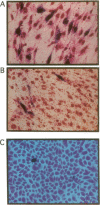Abstract
Electroporation is a common technique for the introduction of DNA molecules into living cells. The method is currently limited by the necessity of applying the electrical discharge to cells in suspension. Adherent cells must therefore be removed from their substratum, which can induce unwanted physiological effects. We report here a new procedure for in situ electroporation of cells grown on microporous membranes of polyethylene terephthalate (PET) or polyester (PE). We demonstrate that this method of in situ electroporation employs only readily available materials and standard electroporation devices without any modifications, is as efficient as conventional electroporation of cells in suspension, and is applicable to a wide range of cell types. Efficient electroporation can be achieved under conditions of minimal cell killing, and can be performed with quiescent cells as well as with confluent epithelial sheets. The method is a useful extension of electroporation technology, and will allow the application of electroporation to a wider spectrum of biological systems.
Full text
PDF







Images in this article
Selected References
These references are in PubMed. This may not be the complete list of references from this article.
- Andreason G. L., Evans G. A. Optimization of electroporation for transfection of mammalian cell lines. Anal Biochem. 1989 Aug 1;180(2):269–275. doi: 10.1016/0003-2697(89)90429-6. [DOI] [PubMed] [Google Scholar]
- Audus K. L., Bartel R. L., Hidalgo I. J., Borchardt R. T. The use of cultured epithelial and endothelial cells for drug transport and metabolism studies. Pharm Res. 1990 May;7(5):435–451. doi: 10.1023/a:1015800312910. [DOI] [PubMed] [Google Scholar]
- Bahnson A. B., Boggs S. S. Addition of serum to electroporated cells enhances survival and transfection efficiency. Biochem Biophys Res Commun. 1990 Sep 14;171(2):752–757. doi: 10.1016/0006-291x(90)91210-j. [DOI] [PubMed] [Google Scholar]
- Boyce S. T., Ham R. G. Calcium-regulated differentiation of normal human epidermal keratinocytes in chemically defined clonal culture and serum-free serial culture. J Invest Dermatol. 1983 Jul;81(1 Suppl):33s–40s. doi: 10.1111/1523-1747.ep12540422. [DOI] [PubMed] [Google Scholar]
- Burger M. M. Proteolytic enzymes initiating cell division and escape from contact inhibition of growth. Nature. 1970 Jul 11;227(5254):170–171. doi: 10.1038/227170a0. [DOI] [PubMed] [Google Scholar]
- Chu G., Hayakawa H., Berg P. Electroporation for the efficient transfection of mammalian cells with DNA. Nucleic Acids Res. 1987 Feb 11;15(3):1311–1326. doi: 10.1093/nar/15.3.1311. [DOI] [PMC free article] [PubMed] [Google Scholar]
- Felgner P. L., Gadek T. R., Holm M., Roman R., Chan H. W., Wenz M., Northrop J. P., Ringold G. M., Danielsen M. Lipofection: a highly efficient, lipid-mediated DNA-transfection procedure. Proc Natl Acad Sci U S A. 1987 Nov;84(21):7413–7417. doi: 10.1073/pnas.84.21.7413. [DOI] [PMC free article] [PubMed] [Google Scholar]
- Fenjves E. S. Approaches to gene transfer in keratinocytes. J Invest Dermatol. 1994 Nov;103(5 Suppl):70S–75S. doi: 10.1111/1523-1747.ep12399089. [DOI] [PubMed] [Google Scholar]
- Heiser W. C. Gene transfer into mammalian cells by particle bombardment. Anal Biochem. 1994 Mar;217(2):185–196. doi: 10.1006/abio.1994.1108. [DOI] [PubMed] [Google Scholar]
- Herzing L. B., Meyn M. S. Novel lacZ-based recombination vectors for mammalian cells. Gene. 1993 Dec 31;137(2):163–169. doi: 10.1016/0378-1119(93)90002-k. [DOI] [PubMed] [Google Scholar]
- Jiang C. K., Connolly D., Blumenberg M. Comparison of methods for transfection of human epidermal keratinocytes. J Invest Dermatol. 1991 Dec;97(6):969–973. doi: 10.1111/1523-1747.ep12491889. [DOI] [PubMed] [Google Scholar]
- Knutson J. C., Yee D. Electroporation: parameters affecting transfer of DNA into mammalian cells. Anal Biochem. 1987 Jul;164(1):44–52. doi: 10.1016/0003-2697(87)90365-4. [DOI] [PubMed] [Google Scholar]
- Leiderman L. J., Tucker J. A., Dennis V. W. Growth and differentiation of opossum kidney cells on microscopically transparent microporous membranes. Tissue Cell. 1989;21(3):355–360. doi: 10.1016/0040-8166(89)90050-5. [DOI] [PubMed] [Google Scholar]
- Parker B. A., Stark G. R. Regulation of simian virus 40 transcription: sensitive analysis of the RNA species present early in infections by virus or viral DNA. J Virol. 1979 Aug;31(2):360–369. doi: 10.1128/jvi.31.2.360-369.1979. [DOI] [PMC free article] [PubMed] [Google Scholar]
- Potter H. Application of electroporation in recombinant DNA technology. Methods Enzymol. 1993;217:461–478. doi: 10.1016/0076-6879(93)17084-i. [DOI] [PubMed] [Google Scholar]
- Prouty S. M., Hanson K. D., Boyle A. L., Brown J. R., Shichiri M., Follansbee M. R., Kang W., Sedivy J. M. A cell culture model system for genetic analyses of the cell cycle by targeted homologous recombination. Oncogene. 1993 Apr;8(4):899–907. [PubMed] [Google Scholar]
- Raptis L. H., Brownell H. L., Firth K. L., Mackenzie L. W. A novel technique for the study of intercellular, junctional communication: electroporation of adherent cells on a partly conductive slide. DNA Cell Biol. 1994 Sep;13(9):963–975. doi: 10.1089/dna.1994.13.963. [DOI] [PubMed] [Google Scholar]
- Raptis L., Firth K. L. Electroporation of adherent cells in situ. DNA Cell Biol. 1990 Oct;9(8):615–621. doi: 10.1089/dna.1990.9.615. [DOI] [PubMed] [Google Scholar]
- Repesh L. A. A new in vitro assay for quantitating tumor cell invasion. Invasion Metastasis. 1989;9(3):192–208. [PubMed] [Google Scholar]
- Schwartz P. M., Barnett S. K., Atillasoy E. S., Milstone L. M. Methotrexate induces differentiation of human keratinocytes. Proc Natl Acad Sci U S A. 1992 Jan 15;89(2):594–598. doi: 10.1073/pnas.89.2.594. [DOI] [PMC free article] [PubMed] [Google Scholar]
- Simon W. C., Raptis L., Pang S. C., Bennett B. M. Comparison of liposome fusion and electroporation for the intracellular delivery of nonpermeant molecules to adherent cultured cells. J Pharmacol Toxicol Methods. 1993 Feb;29(1):29–35. doi: 10.1016/1056-8719(93)90048-j. [DOI] [PubMed] [Google Scholar]
- Sporn L. A., Marder V. J., Wagner D. D. Differing polarity of the constitutive and regulated secretory pathways for von Willebrand factor in endothelial cells. J Cell Biol. 1989 Apr;108(4):1283–1289. doi: 10.1083/jcb.108.4.1283. [DOI] [PMC free article] [PubMed] [Google Scholar]
- Williams R. S., Johnston S. A., Riedy M., DeVit M. J., McElligott S. G., Sanford J. C. Introduction of foreign genes into tissues of living mice by DNA-coated microprojectiles. Proc Natl Acad Sci U S A. 1991 Apr 1;88(7):2726–2730. doi: 10.1073/pnas.88.7.2726. [DOI] [PMC free article] [PubMed] [Google Scholar]
- Zimmermann U. Electric field-mediated fusion and related electrical phenomena. Biochim Biophys Acta. 1982 Nov 30;694(3):227–277. doi: 10.1016/0304-4157(82)90007-7. [DOI] [PubMed] [Google Scholar]
- de Wet J. R., Wood K. V., DeLuca M., Helinski D. R., Subramani S. Firefly luciferase gene: structure and expression in mammalian cells. Mol Cell Biol. 1987 Feb;7(2):725–737. doi: 10.1128/mcb.7.2.725. [DOI] [PMC free article] [PubMed] [Google Scholar]




